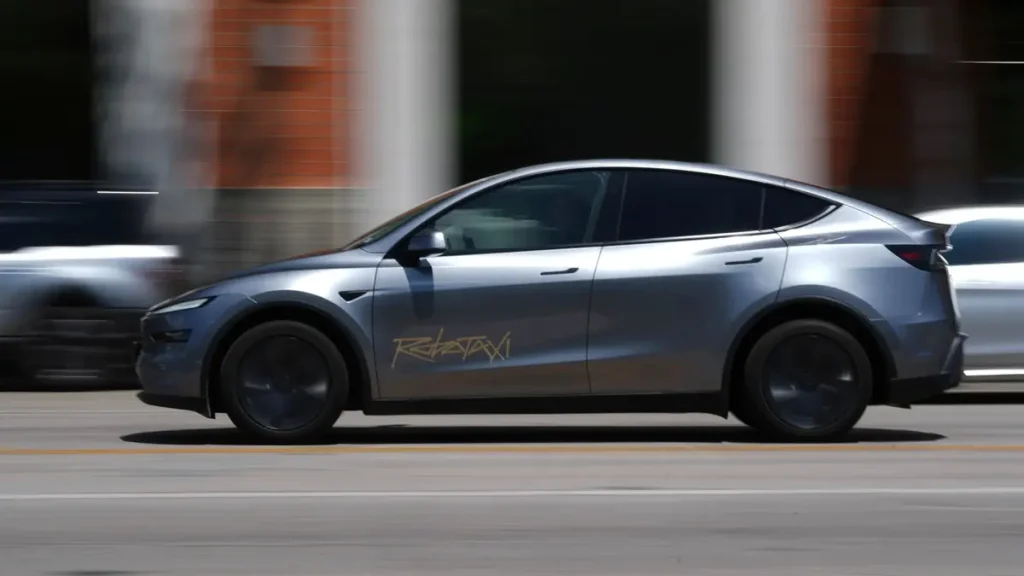Tesla has officially launched its first robotaxi service in Austin, Texas, introducing the company’s vision of fully autonomous ride‑hailing to the public. This historic robotaxi launch demonstrates Tesla’s pivot toward transportation-as-a-service and positions it as a direct contender to established players like Waymo and Cruise.
What Is Tesla Robotaxi?
A robotaxi is a fully autonomous vehicle—capable of operating without a human driver—available to the public for ride-hailing. This model aligns with Tesla’s bold strategy, underpinned by camera-based Full Self‑Driving (FSD) software, to move beyond personal EV sales into scalable transportation services.

Tesla CEO Elon Musk has framed this launch as the “culmination of a decade of hard work”, a milestone in the company’s prolonged journey toward autonomous vehicles.
Details of the Tesla Robotaxi Pilot Program
-
Launch Location: Austin, Texas—Tesla’s de‑facto headquarters and a favorable regulatory environment .
-
Fleet Size: Roughly 10–20 Model Y SUVs equipped with FSD software will serve a geofenced zone.
-
Safety Monitor: Each vehicle includes a Tesla‑employed safety monitor in the front‑right seat observing performance.
-
Flat Fare: Riders are charged a flat $4.20 per trip.
-
Operational Hours: Service runs from 6 a.m. to midnight, avoiding complex weather or road scenarios.
-
User Access: Available by invitation through a “Robotaxi” option in the Tesla app, with rides limited to adults.
Safety, Limits, and Oversight
Despite marketing itself as driverless, Tesla’s Robotaxis currently include a safety monitor in the front passenger seat—an employee ready to intervene via touchscreen or remote controls.
Vehicles operate from 6 a.m. to midnight, steering clear of complex traffic conditions, bad weather, and sensitive areas. Minors and unruly passengers are excluded. Elon Musk emphasizes that operations will use only cameras and neural networks, rejecting lidar or radar, which draws both praise and criticism.
While the National Highway Traffic Safety Administration (NHTSA) reviews Tesla’s plans around weather handling and emergency protocols, U.S. regulators are monitoring closely, especially after visibility-related Autopilot incidents.
Legal Environment in Texas
Tesla benefits from Texas’s permissive regulatory climate, with a law prohibiting local AV legislation since 2017. However, a new state bill effective September 1 introduces safety permit requirements. Some Texas lawmakers have called for a Robotaxi delay until then.
Tesla appears to be pushing forward ahead of this deadline, a calculated but contentious gamble .
Robotaxis’ Full Self‑Driving AI
Tesla’s Robotaxis utilize its proprietary Full Self‑Driving (FSD) software, backed by in-house AI chips and camera-based systems. Teleoperation—remote human oversight—is integral to this setup , though its effectiveness may be limited by network latency.
Critics caution that Tesla is treating a beta-stage service as a full launch, pointing to potential glitches in real‑world scenarios. Still, early rider feedback highlights both excitement and caution about this unconventional entry into ride‑hailing .
Strategic Stakes
Tesla considers Robotaxi services essential to its long‑term valuation—used in many forecasts that tie a $5–10 trillion market cap to mobility-as-a-service.
Since the weekend rollout, Tesla stock edged up 1.5%—a sign that investors welcomed the news, though broader economic and geopolitical concerns remain .
Still, financial and technical challenges loom large: expanding the fleet, meeting regulatory demands, and scaling operations to rival Waymo—which has already logged millions of rides
Challenging Self-Driving EV Market
Industry analysts caution that widespread deployment will take years, given regulatory hurdles, technical complexity, and public acceptance concerns. Tesla must also address safety regulations, incident reporting, and camera-based system limitations .
Nevertheless, this Tesla robotaxi launch is a pivotal moment—a first public step toward making autonomous ride-hailing a viable and mainstream service.
Tesla’s official robotaxi launch in Austin represents both a technological and strategic milestone. While current deployment remains limited, the initiative signals Tesla’s entry into autonomous ride‑hailing—challenging traditional EV business models and reshaping future mobility. With consumer testing underway and major vehicle models under development, 2025 may mark the beginning of a new ride-sharing era.


